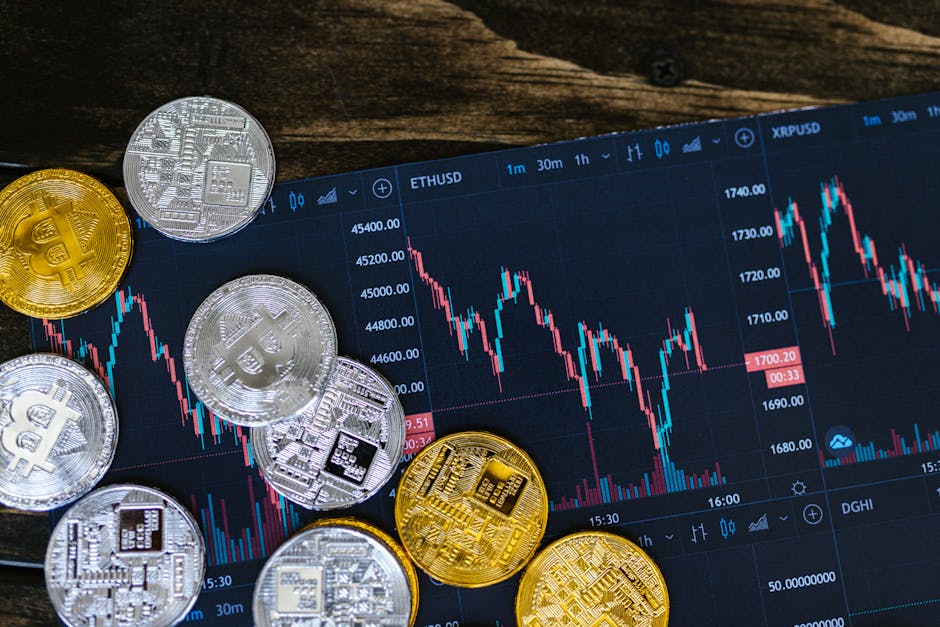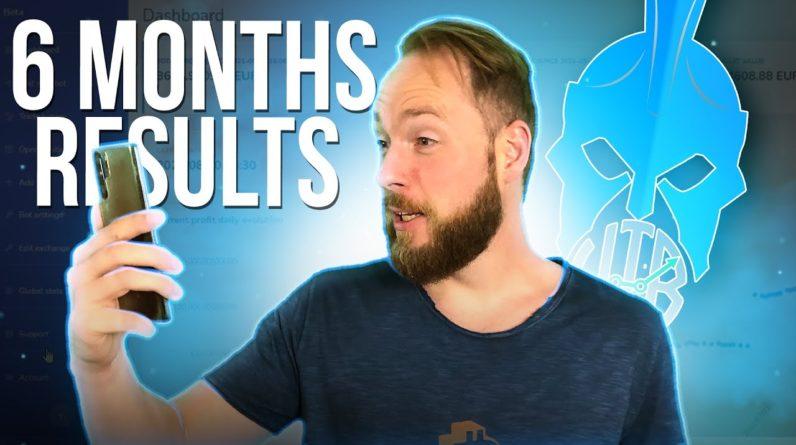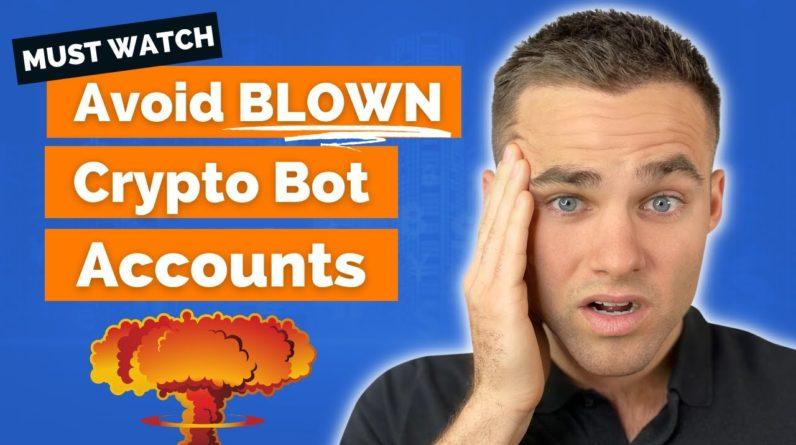Hey guys, welcome to The Trading Parrot. What is Grid Bot trading? Should I consider adding it
to my arsenal of tools? Is it better than DCA bots,
and under what specific market conditions should they be using Grid Bots? What makes a
particular coin great for grid trading? What are the potential risks and rewards? Today we are going to delve into grid bots.
Make sure to watch the entire video, if you want to pick up all the tips,
tricks and secrets to become a grid bot master.
This is The Trading Parrot. In this channel, I mainly focus
on crypto and bots, how to build a top Crypto Portfolio
with huge growth potential, how to get the best
winning bot setups on 3Commas, including DCA, grid bots, signals,
TradingView setups, etc. Make sure to subscribe to the channel
and select the notification bell. This way you will receive a notification
every time we publish the video. In order to gain access
to my Crypto Portfolio, and also to be able to copy
many of the bots on this channel, be sure to join us on Discord. Anyone who joins before we
hit 1,000 YouTube subscribers will be able to keep free access for life. And if you're interested
in getting premium content, like being able to copy the full setups
of top performing bots or getting paid notifications on time,
please consider supporting our channel by becoming a Patreon. All links can be found in the description. This video is organized into different chapters,
from very basic topics to grid bots.
So how to set it up.
What is it about. Even much more advanced tips, tricks and secrets
that are not very common to hear on the web, which I have compiled all for you in a single video. So make sure to take a look
at the description below the video so you can decide
which themes are more suitable for you. And you can maybe,
maybe you want to skip the more basic topics and go straight to the advanced topics,
or when you want to come back to this video to refer to it,
having these direct links to the different moments in the video,
the different chapters is the best way to organize the video
So take a look at the description. Okay, let's start from the beginning. Imagine you have a coin
that does something like this.
It doesn't really matter. What you want normally,
what every trader wants is to find an indicator
that potentially tells us that these are the best times to buy. Pretty simple. TRUE? And that these are the times to sell,
but in fact, this is very difficult to achieve. It's very difficult to build an indicator
that can be so accurate, you know, so precise,
that it tells you exactly where the highs and the lows are,
and that you can trust in the long run that it actually predicts exactly
where the bottoms are, where the spikes , so you can take full advantage
of price movements, but there is actually an alternative
to still benefit from a scenario like this, where you can see prices
going up and down, up and down, up and down ,
without the need to pay for an indicator, without the need to write a known indicator,
and having to have all the knowledge, to be able to achieve such a challenge.
And what it is, you just decide
what's a good range in all this movement that you're seeing on the screen,
and you draw these lines, which is your grid basically. And based on these lines,
what you hope to do is that when the price goes down, you're going to sell. And every time the price goes up,
you're going to buy, simple as that. And you're going to benefit from all these
ups and downs, buying the cheapest price,
selling at the most expensive price, the longer this price trend stays
in the grid range, the more and more money you're going to make.
As you can see, this requires a
lot less of the skills than needing to set up a DCA bot,
thinking about how much diversion you're going to need, who can do it with an indicator,
finding the right indicator, etc. This only requires that you know what the range is
and what currency you want to trade. You need your hypothesis. You need to understand what
the range is going to be over a period of time. And then once it's set up, it
will do all these things for you. Now, I have to mention.
This is virtually impossible to do with manual trades. You need a platform
that offers you grid bots, for example 3Commas, or there are a lot of them.
In fact there are even some that are included in the exchange price.
Some exchanges offer you Grid botting,
which you can use to achieve setups. How to configure a grid bot? It's pretty simple. It only takes four steps to fully define
a grid bot. The first step is that you need to choose
what is going to be the pair that you are going to trade. In this case, USDT for example. The second step is that you need to
decide what is going to be the range in which your grid bot is going to be active.
Within that range, the grid bot
will be placing orders. Outside of that range, the grid bot
will not be doing anything at all. You also have to determine
the number of grid levels. In this case, we have one, two, three and four levels. The more levels you have, the
more funds you will need, depending on how much you are going
to invest in each of the levels. The fourth step is to decide
the global allocation you want to give to this grid. How much money in total
you want to spend on the grid, to buy and sell in each of the levels.
And that's it. That's all you need to set up your grid bot. What makes a particular coin
a great candidate for Grid bot trading? Let's look at the following graphs. Do you spot any trends here? First of all, on chart number one,
we have like a slow uptrend with a little bit of down, going up. On chart number two,
we have a very strong uptrend. On chart number two, we have an area of consolidation, you could
say. And on chart number three,
we have a downtrend. Now, what do you think is the best option? It also depends on your personal preference,
but personally, I'm going to prefer chart number two,
because I can clearly identify that for a period of time,
the price has been range bound.
It also depends on which chart
we're looking at here. Is this the one minute chart
or is it the four hour chart or is it a one day chart? If I were here looking at one day, I
might think, well, maybe I can run this
for a long period. There is a range that is very strong. It's kind of a long-term grid bot. If it was the one minute,
maybe this is going to last for a very short time, and I may have to look
to see if this panel, this channel, is actually going to stay
there any longer. In the downtrend,
chart number three, it is quite challenging to profit from a grid bot. I'm actually going to say
it's kind of a terrible choice, because whatever range you choose,
the bot is going to come off the bottom of the grid,
and it's going to stop at a loss very quickly.
The uptrend is also a challenge,
chart number two, because whatever range you pick,
the bot is going to break out of the top and stop trading. We want the price to stay within
the range as long as possible , so that our bots
can take the profit. And the strong uptrend, it
may be best to place a smart trade, and just sell at the top. In a strong uptrend,
your bot will sell at different levels, little by little,
more expensive and more expensive and more expensive.
If you have a smart trade,
and you are willing to sell here, and you have bought here,
you are going to sell at the maximum price. So the smart trade makes more money
than the grid in a strong uptrend. That is why a grid bot
is not the preferable idea to use in a strong uptrend. A slight uptrend
can be a good idea, as long as you are
sure that the price will stay within the range
long enough for you to profit more
than using a smart trade. The second thing you need to be looking
at in a coin, to make sure you're choosing
the best coin to trade with a grid bot is, do you know anything about that coin? Are you familiar with the project? Do you think the price of that coin
in the long term is going to go up? You want to stay away from projects
that have any indication that they could crash at any time,
and move down, because that will immediately leave you
at a loss in a grid bot.
Remember what happened to Bitcoin in 2017,
when we hit the highest price ever. Imagine if you set up a bot like this at this point
and set all the levels of the grid to the all-time high,
it would have sold Bitcoin at all these levels , but if you don't actually disable it,
the bot at the top, there will be bought at an
all-time high and it leaves you at a loss,
which could take up to 80% down, which is terrible,
because then you'll have to wait for three years to make a profit. You will have to wait for another higher price
, so you will have had to wait for almost three years
to make a profit. You will have to wait until you get
another all-time high. And that explains how bad
a grid bot can go if it is set up under the wrong market. In this case, Bitcoin was
extremely overextended. So setting up a bot like this
would not necessarily be the best option. So summarizing the best scenarios
for a grid bot, there are mainly two.
The first is lateral and consolidation,
and the second is slightly bullish. The first is the one that benefits the most. So if you can identify the coins
that are doing this type of movement, these are the most preferable scenarios
to use with a grid bot. Things to avoid,
the downtrend, and go parabolically bullish. Stay away from those. And when it comes to which pairs to use,
stay away from running grid bots on currencies you don't believe in. And you actually have to make
sure that in the pair, you like both the base currency
and the quote currency. Both. You have to believe in them,
because in the worst case, you will end up with one of them and you don't know
in advance which one.

So it's much better to end up
with the reverse side of a coin that you believe in
than to end up with something completely unknown, which in reality,
you don't know what's going to happen with it. Can a stop loss be set
on a take profit in a grid bot? If possible.
But most of the platforms, they only offer the very basic setup tools,
while Pionex, this exchange, they offer you take profit,
they offer you stop loss, and what is even more interesting,
they offer you an entry price. The entry price is a price
that actually activates the grid. If you do not reach the price,
the grid will remain disabled. I find this option pretty cool
because it could tell my grid not to start trading
until the price is halfway through the channel, for example. Instead of starting the grid when the price
is still at either edge of the grid.
Let's see the difference between a narrow and a wide
grid configuration. In a tight setup,
you will have a pair, for example, BUSD versus USDT,
which the fluctuation is very humble. It's very little, it doesn't really move much,
but it moves constantly. So it's much more efficient to
have a very narrow set, where the difference between the top and bottom
is extremely small, but you really benefit
from those micro-fluctuations in price. You can also have
wide grid settings. For example, many people
have been trading BTC with grid bots. They've been using ranges
that can go from 2K to 20K and they've been running them for months
or for years, because they expected BTC to,
you know, behave like BTC behaves.
Once we know what the range is going to be,
whether it's going to be a wide or a narrow one, you have to decide how dense
you want your grid to be. You can have maybe only four levels,
or some people even go with 20 or 30 levels. The limitations,
above all, come from the exchange. Your exchange will tell you how many orders
you can have open at the same time. And the second limitation
is the amount of funds you have, because if you want to keep
the amount of investment in each of the grid levels static,
adding more levels is only going to consume a lot of money from your pocket.
Whereas if you have a finer grid
with fewer levels, it's much easier to achieve. Also keep in mind
that if the price does not visit each of the levels, those levels are going to be a loss of funds. Are you trying to identify
which pairs are lower risk to trade on a grid bot?
Well, there are many options. I'm only going to give you three tips. The first tip is that you can use,
for example, BUSD against USDT.
Right now, there are no commissions on Binance,
at the moment I'm shooting this video. And this option is a great option
because there are tons of little micro fluctuations in price that you can take advantage of. Another way to trade low risk
with grid bot is by choosing competitor pairs,
for example, let's say hypothetically, you think Ethereum versus Cardano
are really competitors. You think one or the other is actually
going to end up winning the battle. That, as a pair, is a great pair,
because if you're holding a back with Cardano and Ethereum,
and in the long run, let's say, the big winner is Cardano, there's
going to be a lot of fluctuations during the battle.
And at the end of the day you're going to end up holding the winner, which is a great opportunity,
you know, to steal the lead as a win.
A third tip that I am going to give you is that you use
large cap tokens. So if you choose Bitcoin, Ethereum,
any of the top 10 large cap tokens, they
are great options to trade against USDT. Of course, they can have a bad time.
They may go down eventually, but they are expected to recover eventually
, which makes them much safer than if you have to go for
small caps or altcoins that especially when you don't have any background information
on them to feel safe , that if things go away,
you'll be comfortable keeping them until they recover. But if you are looking for high risk,
high reward setups then you can go for these two options. You can choose leverage tokens,
for grid bots. Those are great alternatives to maximize profits.
Although they come with a price
of higher risk. You can also choose from small cap tokens,
because they benefit from very high volatility. Therefore, you would expect them to cross
all the different levels of the grid much more frequently. Do you have two coins where you are not
sure that both projects will win? Have you identified that these two projects
are actually competitors? One will win
and the other will lose. You are not sure who will be the final winner. No problem. You can use a grid bot to actually
use that grid bot also as a tool to diversify.
Let the grid bot decide
who is the winner. Set up between Ethereum and Cardano
and let the grid bot decide which one is going to win. Grid Bot profit loss
are most of the times false or misleading. Let's look at a grid versus a sell limit order. If you have this grid bot,
and you see a very strong uptrend, and you have it set up like that, you will see profit,
you will see that this grid bot sold at a profit, but the profit is still less
than if you buy here at this level and a order to sell here,
this profit will be higher than crossing all these prices with a grid bot,
and for that reason, number 1, the NLP grid bot is wrong,
it's not as high as if you sold at the highest level.
Therefore, the grid bot is not doing you a favor, it
is actually punishing the profit that you could have made
with a simple sell order limit. The second reason why grid bot profit loss
is false is because of the realized versus unrealized profit and loss. Let me explain this. Imagine that you have a currency that is moving sideways
within the channel. You have perfectly configured your grid bot there.
So you will see all the profit from the sale at a higher price,
accumulating one by one, but suddenly it falls sharply
out of the grid to the bottom. In your profit and loss, you would not see that. You will only see the positive benefits of the sale. And because this bot when it went down
was actually buying, you wouldn't see what the effect of this is. And that is why it is quite difficult
to understand the real profit and loss of platforms
like 3Commas. They don't show you the unrealized NLP, they
only show you the realized ones. So whenever you're looking
at your grid bot's profit and loss, you have to look at the chart
and see where you are with the chart, to have an understanding of whether that profit
and loss is really accurate.
The only way I can be 100%
sure that the NLP that the grid bot is showing me, especially when it is just the one performed, is accurate,
is if I see that I enter the grid, at one price, and then exit at the same price. So I'll look at all the profit made
and confidently say that's accurate NLP. If the price breaks out of the top,
I'm going to look at the price to the very entry point and say, okay, that's my NLP,
but once it breaks out of the top, I'm going to feel like it's
still hurting my benefit compared to placing an order,
which is still much better than exiting the grid from the bottom. Let's take a look at the drawbacks of running
grid bots on 3Commas. Please don't get me wrong.
I run all my grids in 3Commas. I love it, but it's good to know
what the limitations are. This way you can take it into account
when evaluating how good or bad the results are. The first drawback
is that there is no entry price tracking.
And as I was mentioning,
knowing the entry price will tell me exactly how much profit the realized profit is. And I can consider successful the performance of my grid. There is no distinction between realized and unrealized NLP. This is a big drawback.
I hope they get better at displaying stats so you can really understand
when a grid bot is doing a great job or not
and don't be fooled by overinflated NLP.
There is no option for take profit/stop losses or trigger price,
like other competitors. So, ok guys, if you liked this content,
please consider subscribing to the channel, select the notification bell. So you get a notification every
time we upload a video, and please give it a Like.
Comments are the best thing you can do for this channel. Now, if you want to have access to our DCA bots,
all the setup, all the database, all the grid bots that run,
and all the signals too , please consider becoming a Patreon.
Trading Parrot's Patreon will give you access
to all of those things, including all of the private channels
on Discord. See you at the next one..







